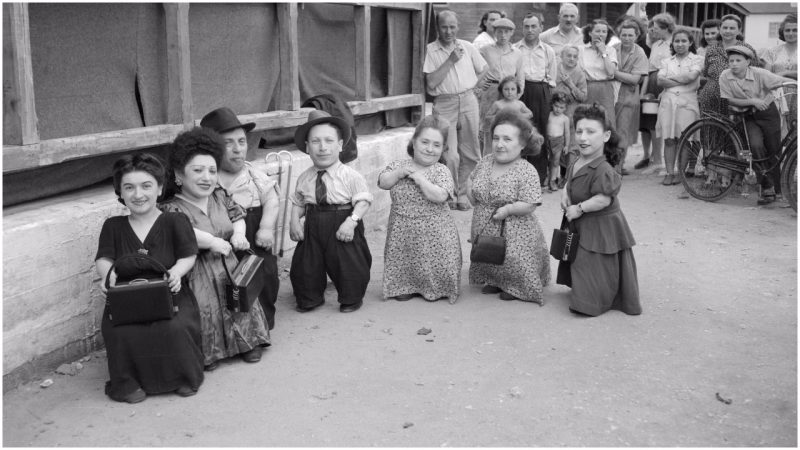In Nazi-occupied Europe, little people, or as is more commonly called, dwarfs, was to be under direct threat. The T4 Euthanasia Program targeted those who were disabled, mentally ill, mentally challenged, or suffering from hereditary growth disorders, and more than 300,000 perished in concentration camps or were simply given a “merciful death” by the staff operating under the T4 Program.
Shortly before the war, in Romania, a family of dwarfs was performing as an entertaining group―dancing, singing, and playing miniature instruments. The Ovitz family, which performed under the name the Lilliput Troupe, traveled between Hungary, Romania, and Czechoslovakia, performing in various languages, including Yiddish, Russian, and German.
In 1940, a racial law was introduced that prohibited Jewish entertainers from performing. The Ovitz family had no choice but to conceal their Jewish origin while continuing to make ends meet in the times of war.
The group consisted of 12 members who were all related and were all short in stature. On May 12, 1944, seven members of the Lilliput Troupe, all of them being dwarfs, were apprehended and transported to Auschwitz. It was there that their worst ordeal began.
The ones who’d escaped initial capture were the ones whose height was normal, but they met their demise in front of various SS firing squads.
Faced with a death sentence due to their growth disorder, the Ovitzes were living in fear, counting their days in Auschwitz. Perla Ovitz, one of the surviving members who later gave her testimony of the events, recalled that they were put into something that she thought was a gas chamber. Their execution, so she thought, was interrupted by none other than the Auschwitz Angel of Death himself, Dr. Josef Mengele.
Mengele was well-known for “collecting” people who differed by appearance due to some physical trait. He considered the Ovitzes a special curiosity, as the family had members of normal height as well as ones who were, due to an inherited growth disorder, of much shorter stature.
Mengele was mainly interested in genetic research, which is why he experimented on twins as well as dwarfs.
Once they entered the experimental program, they were under the protection of Mengele. They were fed better and were allowed to keep their clothes. Also, their hair wasn’t cut short, for Mengele needed their tresses for various samples as he was interested in all the aspects of the growth process of his test subjects.
Soon, other dwarf inmates joined the Ovitz family, claiming they were all relatives. This fascinated Mengele, whose curiosity managed to override his murderous intent.
Since he always lacked a large number of dwarf “guinea pigs,” he tended to them with care, and would think twice before subjecting them to mortal danger in his hideous experiments.
This doesn’t mean that the Ovitz family and their fake relatives weren’t exposed to terrible treatment. The physicians at Auschwitz extracted bone marrow, teeth, and hair samples in order to find proof that dwarfism was a hereditary disease. Mengele had the freedom to do whatever he wanted in his human experiments as his research was solely guided by the Nazi ideology that desperately attempted to affirm itself with the help of pseudoscience and false eugenics.
Gynecologists inspected the women of the family, while Mengele himself got an interest in examining the blood samples of the 18-month-old Shimshon Ovitz, who was prematurely born to the taller parents but who was himself suffering from the growth disorder. The doctors drew blood from the baby on a daily basis, keeping it in a constant near-death condition.
Due to the extensive research conducted by Yehuda Koren, who authored the book titled Giants: The Dwarfs of Auschwitz, later readers learn the story of the Ovitz family, including the everyday life in the death camp.
According to the book, Mengele was so excited about the fact that he had 22 dwarfs at his disposal―all claiming to be related–that he exclaimed in delight, “I now have work for 20 years!”
Even though they held a better status than the rest of the inmates, not all dwarfs were as lucky as the Ovitzes. Members of the family claimed that they personally witnessed two persons of lower stature being killed and boiled so that their bones could be exhibited in a museum. The whole macabre procedure was captured on film, but the rolls were never found.
The book also includes anecdotes about the horrid “nightlife” of the camp in which the Ovitz family was forced to perform their acts as the Lilliput Troupe in order to please the sadistic SS officers who craved entertainment.
On January 27, 1945, Auschwitz was liberated. The Ovitz family had the double misfortune of being both dwarfs and Jews, which had made them a clear target for the Nazis. Somehow, they all managed to survive the war, as did their tormentor and accidental savior― Josef Mengele, who managed to escape, presumably to South America.
The seven original members of the family emigrated to Israel in 1949, where they continued to perform under their old stage name, the Lilliput Troupe. The last member of the Ovitz family who witnessed the horrors of Auschwitz died in 2001.
